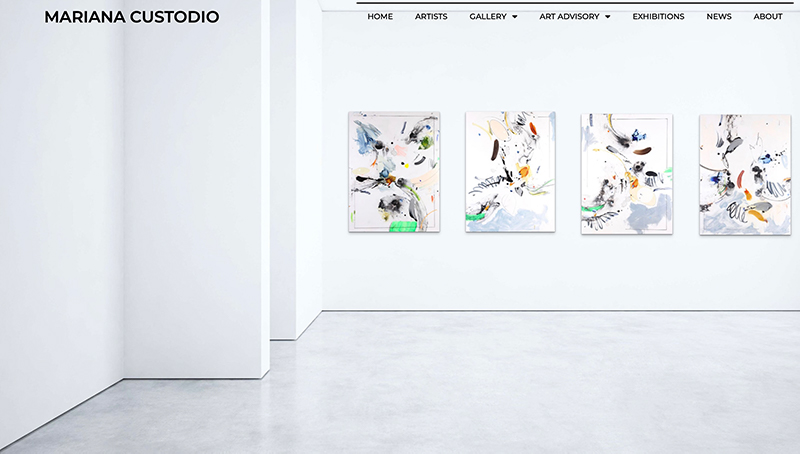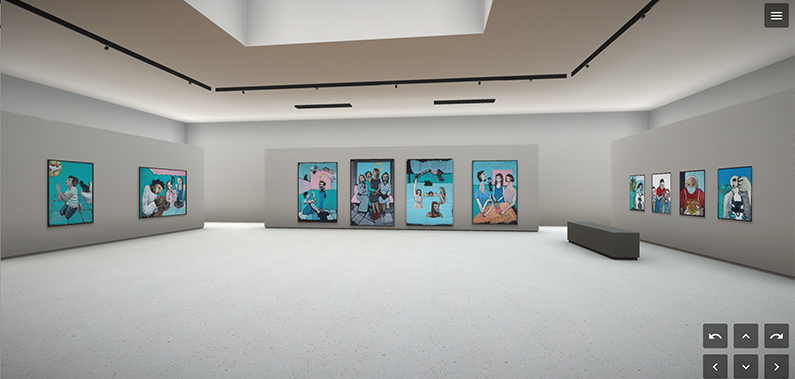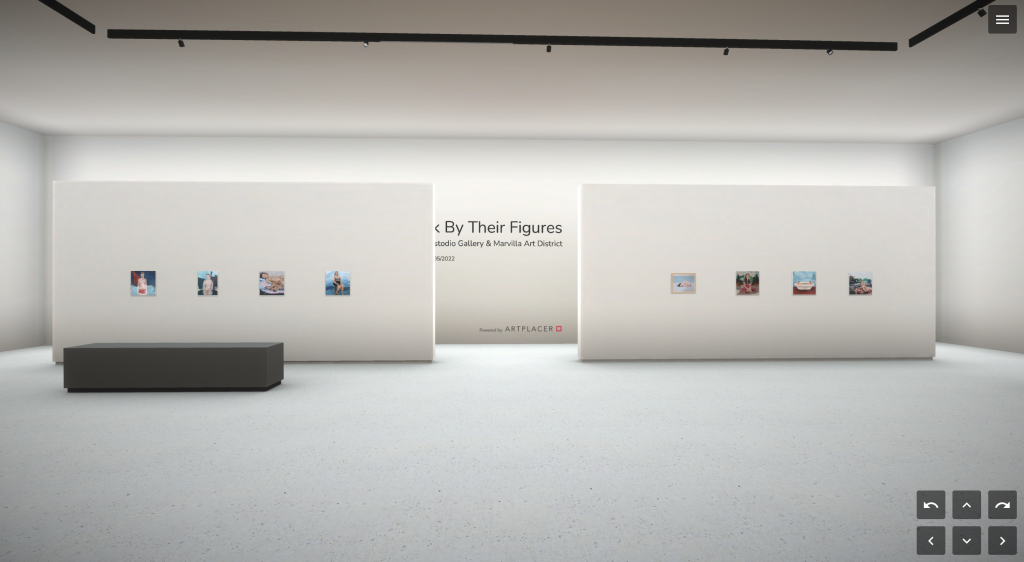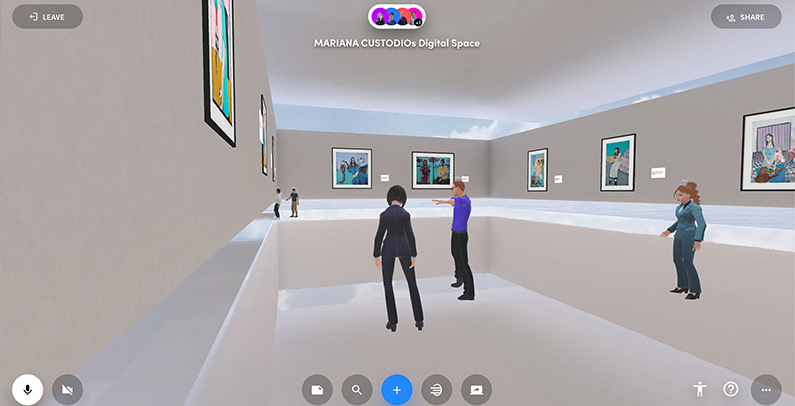A virtual art gallery is a website used to showcase various art pieces. It is also a platform of interaction between artists and their audience. Numerous prominent art repositories run virtual galleries, one being the New York New Exhibitions Museums. Yet, can you create and run an individual virtual gallery?
It is pretty easy to create a personal virtual gallery, although not that easy to run it. There are some facets you should contemplate before doing this; they include an appropriate software or website, the artworks you want to exhibit, and the quality of the images you will post on your website. The main reason for creating a virtual gallery is to market your artwork.
I will give an in-depth delineation of what a virtual gallery is and how you can create yours and make the best of it. Technology is changing numerous aspects of society, and art exhibition is no exception. I believe after you finish reading this article, you will be able to run your online gallery profitably.
What is a Virtual Gallery?
If you wanted to see an art piece in ancient times, you would avail yourself at physical art galleries, but things took a different turn in the 21st century. Today artists have resorted to showcasing and selling their works online as it is easier to reach many people that way.
A virtual art gallery is an online gallery that offers an interactive experience and features the art pieces one wishes to display. Artists prefer digitisation, given that many of their audiences spend most of their time on their phones, tablets, or laptops.
Virtual galleries are coming to light because they have numerous advantages to artists, art collectors, and the community. If you believe you are doing great work as an artist, you should embrace digitisation because the world should see your marvellous enterprise.
How Did Virtual Galleries Come To Be?
Many people have been exposed to virtual reality during the COVID-19 pandemic. The Google Arts and Culture Initiative was instigated in 2011. The interest in virtual reality can be traced back to 2015.
Since 2011, artworks have been easily accessible via technology, but not many people realize this. Many museums and galleries were launching their online platforms during this period, but many individual artists and art galleries were not doing the same.
The coronavirus has coerced numerous cultural institutions to lock their physical locations and satisfy consumers’ needs via the internet. Since there was restricted movement due to governmental lockdowns, they had no choice but to opt for virtual tours.
Because of the pandemic, many artists and art galleries have turned to technology to produce their works in virtual reality, mixed reality, and augmented reality. Before the COVID-19 pandemic, artists had no interest in virtual reality, but today they are amazed by its capabilities.
Preliminary to 2020, art digitisation was mostly perceived as a bonus to expand one’s audience since physical space was more valued. But today, physical spaces are not a priority, and that is why artists and gallerists must know how to create and run virtual galleries- the trends are changing, and chances are things may never go back to what they were before.
Why Should I Create A Virtual Gallery?
You might be asking yourself why you should create a virtual gallery and whether it will benefit you. There are innumerable motives why you should go virtual; the internet would not only offer you the opportunity of achieving new costumers from another parts of the world as can expose you to different art forms that can also inspire you.
Through your virtual gallery, your viewers can still enjoy the experience of a real gallery. However, if you had a physical gallery, you would only reach a few individuals in your community, which may not work in your favor.
What are the Benefits of Virtual Galleries?
If you set up a virtual gallery, it will never be closed, meaning your visitors would not be constrained from accessing your work. Isn’t this lovely? You can choose to run your gallery 24/7; hence, virtual galleries guarantee time flexibility, unlike physical ones.
Virtual galleries can never be congested. Millions of individuals globally can access your work at the same time. They do not need tickets or early booking. You will not experience rush hours, and your visitors must not make long queues before accessing your work. Many individuals hate going to physical galleries because of overcrowding and numerous limitations.
No pandemic can stop you from working if you have your virtual gallery. Art digitization is pandemic proof since your visitors will not physically contact strangers. The only obstacle you may face is yourself since this medium makes it possible for you to keep at it under any unfortunate circumstances.
Visitors can interact with artists and appreciate their works- this is quite rare in physical exhibitions. That being so, you have no idea how many individuals desire to meet you if you are an artist. In addition, you will be more motivated and feel good about yourself if people compliment your work.
There are many restrictions attributed to running a physical art gallery. For instance, you must have a license and pay admission fees. These charges do not apply to online museums. They are quite easy to run since they have minimal requirements.
Virtual galleries are children-friendly. They do not restrict art to being a thing of grownup professionals. Children can gain a 360 view of various artworks and enhance their interest and creativity through these platforms. Hence, virtual galleries include people of all ages and backgrounds.
Virtual galleries are easy sources of education and entertainment. Digitization has created freedom and more insight into art as people of all age groups can now interact with art pieces and interpret them at their own pace. People establish intimate voyages with various art exhibitions, and through virtualization, people can research more about art items.
Virtualization enables artists to conserve their priceless works of art. If you are unsure whether to showcase or preserve your work, you should turn to digitization. This way, you will display them while applying the necessary conservation measures.
Virtual galleries do not call for drop-offs and pickups as it makes buying artworks as easy as making any other online purchases.
Suppose you have a virtual gallery where you showcase your work; you will be exposing yourself to life-changing opportunities considering managers and prominent gallery owners might notice your work and endorse you in big business deals.
Today, many people prefer virtual tours to physical exhibition tours because they find it easy to relax without too much pressure. The only way you can be part of this is by creating your virtual gallery.
How Do I Run A Virtual Gallery?
As you are already aware, you must be willing to integrate your business with the online world to sell art.
The first step is setting up a free account. You have numerous sites to choose from, and some of them include Kumospace, Exhibit Virtual Art Galleries, ArtPlacer Virtual Exhibitions, and VR Art Platform. These websites do not limit how you sell your art based on geographical location, time, and space.
You will need to fill in basic background information before you get approved. The information includes your preferred username, actual name, the place you are residing, email address, and whether you are an artist, photographer, or student. In addition, you will clarify whether your exhibition is a museum, art gallery, or collection.
Choosing a website is quite crucial since they have varying resolutions. Some sites have management software and a mobile app that make them pretty easy to navigate. You can also create a virtual gallery in Google Data Studio and Google Slides.
What Next After Creating An Online Account?
After creating an account, you should upload at least one art piece. Depending on the website you choose, you will get guidance on uploading your artwork, but this is not a complex process.
Be sure to select an artwork you perceive as important and outstanding. Remember that first impression is vital because it depicts your style and vision. Most importantly, you need not worry about how your audience will view your work as long as you post high-quality images.
You should know that some hand-made art pieces may not be as appealing as they would be in physical space, but it is up to you to decide. In case you choose to showcase your hand-made works, remember to include their pieces, dimensions, titles, and other crucial information that may be of value to your clients.
An important aspect you must not ignore is photography. If you are not a good photographer, you should consider taking classes on platforms like Skillshare or hiring professionals because clients get attracted to high-resolution images.
High-quality photos are highly dependent on good lighting. It might be easier to photograph drawings and paintings, but sculptures require more work. You have to set an ideal background and ensure your audience attain an all-round view of the piece.
If you experience trouble managing your account, you can hire someone to do it for you, but of course, you will incur extra costs. But I guarantee you that it is quite simple; you will not need help, especially if you choose a mobile app website. Furthermore, you can photograph your work and instantly upload it to the app if you have a good phone.
How Do I Market My Work on A Virtual Gallery?
After setting up a virtual gallery account, the most important yet challenging task is marketing your work. How will people know about your work?
You must decide on your marketing budget, including the costs of building a website and paying for your domain. Not everyone can create and design a good website, so you might need professional help with that. If you choose to create an account via free service, remember to watermark your work because people are fond of stealing other people’s works.
You can also choose to join marketing communities to help you market your work. You might have to pay a small fee for this, but you can opt for free services. I would rather you pay for marketing because free things are not always without fault.
There are numerous ways you can market your virtual gallery. They include social media, email marketing, search engine optimization, and referral marketing. You have to work hard to promote your work because once you gain a considerable audience, your life will take a different course.
There are countless mediums you can use to sell your artwork. For instance, you can get big audiences on eBay and Etsy. Alternatively, after setting up a virtual gallery, you can collaborate with other galleries to sell your work.
Always ensure to collaborate with virtual galleries with larger audiences than you. Also, research their style and ensure it aligns with yours.
How Will Your Customers Buy From Your Virtual Gallery?
After marketing your website, you will gain good traffic, after which many people will start showing interest in your work. Clients can easily buy your work as long as you display art measurements and prices. After that, you should offer them a certificate of authenticity and receipts. It would be best to have a return policy to make clients earn your trust.
How Do I Package and Ship Works of Art to Clients?
It is easy to wrap up and ship small works like canvas papers, but big artworks are somewhat delicate. You need not worry as long as you invest in packing and shipping materials like boxes and cardboard corners specifically designed for works of art. You should have good packaging skills to minimize shipping costs.
You should get shipping insurance just in case some of your packages get lost or damaged under the care of a standard carrier. Also, you should choose a good shipping service, especially if you are selling expensive artworks to minimize unanticipated losses.
Why Virtual Gallery?
A virtual gallery will give you a platform to create new trends. No one will limit what you choose to express. Today, many artists have taken advantage of digitization to express themselves to the world in manners they could not before. Virtual gallery is not just a financial incentive; it is a game-changer.
I hope you have gained critical insight from this write-up. I wish you luck as you create your virtual account. Always remember to be cautious, especially on copyright issues and plagiarism issues. Do not copy someone else’s work and ensure others don’t copy yours.
References:









